Using an advanced modulation technique, the first two satellites from Europe's new Galileo satellite navigation and positioning system were able to relay data in a manner that ensures it is completely interoperable with the American-built Global Positioning System (GPS).
The European Space Agency (ESA) was tasked a few years back by the European Commission with constructing a new satellite navigation system, to rid Europe of its heavy reliance on GPS for this type of data. The Galileo constellation is the direct result of this request.
The first two satellites in the series took off aboard a Russian-built Soyuz-FG delivery system on October 21, 2011, from a special launch pad built at ESA's Kourou Spaceport, in French Guiana, South America. The vehicles made it to orbit safely, and successfully passed commissioning tests.
Recently, commands were uploaded that requested the satellites to transmit a series of dummy signals back to Earth, using a modulation scheme that was developed in order to allow full interoperability between Galileo and GPS, once the former enters active duty.
“This is an advanced modulation technique that offers robust protection against signal interference and the misleading signal reflections known as ‘multipath’,” explains the leader of the ESA Galileo System Services, Marco Falcone.
“Significantly, this is also the European version of the Multiplexed Binary Offset Code signal standard agreed with the United States for the interoperability of Galileo and GPS,” the official goes on to say.
“So this transmission helps demonstrate how the two systems will work together in future with no risk of signal interference,” Falcone explains further. He adds that the full Galileo constellation will features no less than 30 satellites, capable of providing global services.
Later this year, ESA plans to launch the third and fourth Galileo spacecraft, also aboard a Soyuz rocket. According to experts, four is the minimum number of spacecraft required to accurately fix a target's position on the surface of the planet.
At this point, it's currently unclear when Galileo is finished. However, ESA plans to accelerate its current satellite assembly speed, and increase the rate at which it launches new spacecraft to at least 4 per year.

 14 DAY TRIAL //
14 DAY TRIAL //